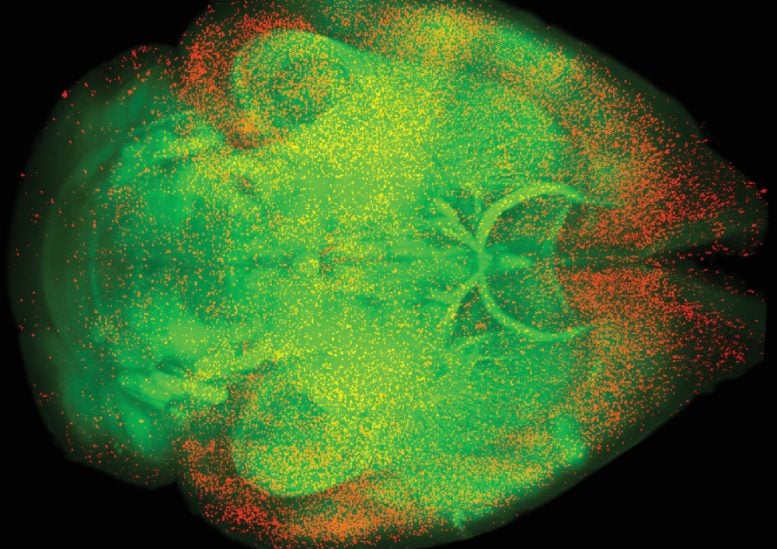
Opioid receptors located in the dorsal peduncular nucleus uniquely contribute to the rewarding effects of opioids.
Opioids, such as the widely prescribed painkiller oxycodone, are notorious for their high addiction potential. In 2022, opioid overdoses claimed the lives of nearly 85,000 people in the U.S., as reported by the Centers for Disease Control. Despite this, opioids continue to be prescribed at concerning rates, especially in Southern states, largely due to the scarcity of effective alternatives.
Researchers at MUSC and around the country are studying the brain to understand more fully what makes these drugs so addictive in the hopes of finding better, nonaddictive medicines for pain relief. Alexander Smith, Ph.D., now an assistant professor in the Department of Neuroscience at MUSC, made a groundbreaking discovery about how opioids function in the brain during his post-doctoral training in the lab of Paul Kenny, Ph.D., at the Icahn School of Medicine at Mount Sinai.
New Discoveries in Brain Research
In a study published in the journal Science, Smith and his team found that an understudied brain region responsible for aversion, the dorsal peduncular nucleus, is highly responsive to opioids. Surprisingly, the opioid receptors in this brain region respond uniquely to opioids, contradicting the prevailing belief that opioids act primarily through dopamine in the brain. This discovery offers an exciting new area of research.

“This is potentially a nondopaminergic mechanism for opioid reward, which is something people have been looking for a long time,” said Smith.
The cells that release dopamine are normally set to an on position. But another cell, called an inhibitory neuron, keeps it from releasing dopamine. These inhibitory cells have mu opioid receptors, a subtype of opioid receptors, on them. When opioids bind to these receptors, it blocks the action of the inhibitory cell and allows the dopamine-releasing cell to flood your brain with the mood-enhancing neurotransmitter. This process is called disinhibition.
Groundbreaking Findings on Opioid Receptors
The team, led by Smith and his mentor Paul Kenny, found that mu opioid receptors are abundant on cells in the dorsal peduncular nucleus. The opioid receptors in this region do not result in disinhibition; rather, they are found directly on cells that project to a part of the brain that drives aversive feelings. When opioids bind to these cells, they inhibit them. Removing these aversive feelings leads to reward – a process called negative reinforcement. This contributes to the pleasurable and addictive qualities of opioids.
“We found the mu opioid receptor in a part of the brain that no one expected it to be, and that really goes against all the dogma,” Smith said. “This is a population of cells that are directly responsive to opioids, which is not the way things usually work.”
For decades, many addiction researchers have primarily focused on studying four parts of the brain: the extended amygdala, the ventral tegmental area, the nucleus accumbens, and the prefrontal cortex.
“Studying those four regions hasn’t gotten us very close to developing an actual therapeutic to treat opioid use disorder,” explained Smith. “So, we are trying to take a more holistic view and look at what else might be happening in the brain.”
When Smith got his early results back showing that the dorsal peduncular nucleus was the most significantly affected region by opioids, he had to look up what this brain region did.
“When I found out that it was in the prefrontal cortex, which is part of the brain I’ve looked at thousands of times, I was very surprised,” shared Smith. “I couldn’t believe I never noticed that.”
While recognizing the importance of the dorsal peduncular nucleus in response to opioids, they determined this brain region’s function by stimulating it. This showed that the dorsal peduncular nucleus is required for aversion. They also found that when they deleted the opioid receptor from this brain region, opioids were no longer rewarding. In fact, they became aversive without the opioid receptors in the dorsal peduncular nucleus.
Smith calls this his most exciting piece of data; he had never seen opioids switch from rewarding to aversive before. When mice without opioid receptors in the dorsal peduncular nucleus were made dependent on opioids, they showed worse withdrawal symptoms. These findings suggest that this brain region is not only involved in the rewarding properties of opioids but also the aversive aspects of opioid withdrawal. This further supports their finding that the opioid receptors in this brain region are critical for the development of opioid addiction.
Smith hopes that in the future, scientists will find ways to target this brain region to help people with substance use disorders by preventing the return to use (relapse) and reducing craving and withdrawal. He also hopes this discovery will lead to the development of nonaddictive painkillers.
Reference: “A master regulator of opioid reward in the ventral prefrontal cortex” by Alexander C. W. Smith, Soham Ghoshal, Samuel W. Centanni, Mary P. Heyer, Alberto Corona, Lauren Wills, Emma Andraka, Ye Lei, Richard M. O’Connor, Stephanie P. B. Caligiuri, Sohail Khan, Kristin Beaumont, Robert P. Sebra, Brigitte L. Kieffer, Danny G. Winder, Masago Ishikawa and Paul J. Kenny, 7 June 2024, Science.
DOI: 10.1126/science.adn0886
The study was funded by the National Institute on Drug Abuse, the National Institute on Alcohol Abuse and Alcoholism, and the Cure Addiction Now Foundation.